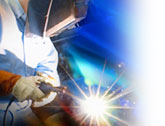 |
Q: What features should I look for in a TIG machine?
A: The most basic elements are DC or AC/DC welding output (DC for ferrous metals, AC for non-ferrous), amperage range and duty cycle. Professionals welding aluminum will want to purchase a machine using squarewave or advanced squarewave technology. Other important features to consider include ease of use, pulsing capabilities (especially to minimize warping on stainless), sequence control (often used to prevent crater cracking) and type of arc start. High frequency (HF) start-only or continuous HF are common; most Miller machines also feature Lift-Arc™ to provide positive arc starts without HF.
Q: What is squarewave technology?
A: Squarewave AC output technology, invented by Miller 25 years ago, minimizes the problems inherent with AC TIG welding: arc rectification, arc stumbling, arc wandering and arc outages. These problems typically occur during the Electrode Negative (EN) to Electrode Positive (EP) transition of the AC sine wave. Squarewave technology shortens the switching time between EN and EP so that the welding machine has sufficient “push” to drive the arc through the zero crossing and then re-establish the arc in the opposite polarity. This minimizes arc instability problems, creating a much more desirable arc and improving weld quality. Today, all professional AC TIG machines feature squarewave technology.
Q: What's the difference between squarewave and advanced squarewave technology?
A: Advanced squarewave technology switches the weld polarity thousands of times faster than a conventional squarewave machine, dramatically improving arc starts and arc stability. It also permits more precise control over the weld puddle, bead width and penetration by adjusting output frequency and extending balance control. In many applications, it can increase productivity by 25% and provide a payback in less than five months.
Q: What's an inverter-based welding machine?
A: An inverter machine uses special power switching semiconductors that boost the frequency of the incoming power from 20,000 to 100,000 cycles per second. Because increasing frequency permits reducing the number of copper windings and mass of the iron core within the transformer, an inverter's transformer can weigh about as much as a bowling ball.
Q: How can I tell if an inverter-based machine is right for me?
A: Inverters offer many advantages that can improve your operation, including lightweight portability, space savings and primary power flexibility. Inverters for production weigh 37 to 89 lb., where a conventional TIG/Stick machine weighs 389 lb. Inverters shrink floor space requirements, too; they can even be mounted on a wall. This advantage may let you add more arcs without expanding building size. Inverters also provide input power flexibility. Where conventional TIG machines only accept single-phase input power, Miller inverters feature Auto-Link¨ or Auto-Lineª technology that allows them to accept single- or three-phase power and multiple input voltages without manual relinking. You can plug these machines in anywhere.
Q: Do inverters always cost more than conventional units?
A: Not necessarily. For example, the Maxstar 200 full-featured model lists for just $2,200, yet has an output of 200 amps at 40 percent duty cycle. This is more than enough power for most DC TIG fabrication and hard on the heels of the Syncrowave® 250 DX (200 amps at 60 percent duty cycle). Mechanical contractors can find an even better bargain with the Maxstar 140 — a complete TIG welding package with this power source list for only $1,200.
Q: Don't inverters have reliability issues?
A: Bad experiences with other brands of welding machines should not reflect on the rugged construction and durability of the current generation of Miller inverters. Miller inverters use fewer parts, feature more robust designs and undergo harsher-than-real-world reliability testing. As a result, some of the biggest users of Miller inverters have converted from other brands to improve reliability. For example, one mechanical contractor working on a cheese plant had 12 of 15 competitive inverters fail within two years. After switching to the Maxstar 140, he reported zero failures. Another mechanical contractor actually replaced his conventional 255 amp squarewave machines with Maxstar 300 inverters to prevent grinding dust from short circuiting control boards.
© 2002 Miller Electric Mfg. Co